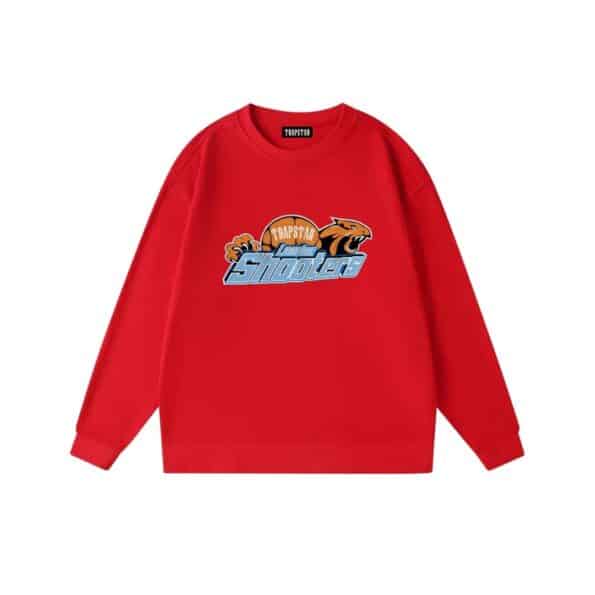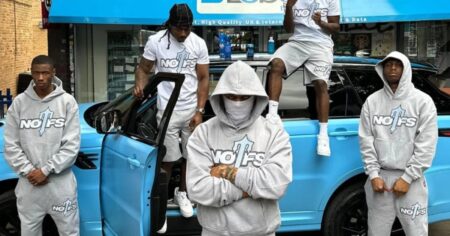Trapstar, a name synonymous with urban streetwear and high-fashion culture, has grown into a globally recognized brand. Known for its iconic designs, bold prints, and association with celebrities and influencers, Trapstar has captivated fashion enthusiasts for years. But to fully appreciate Trapstar’s impact on the fashion scene, we must delve into its origins.

The Early Days of Trapstar
Trapstar was founded in 2005 by three close friends—Mikey Trapstar, Lee, and Will—who hail from West London. With a deep love for street culture, music, and fashion, the founders initially started creating limited-edition graphic T-shirts that they would sell to their local network. The brand grew organically, as Trapstar clothing quickly gained traction due to its unique aesthetic and appeal to London’s underground culture.
Inspiration Behind Trapstar
The name “Trapstar” itself is deeply rooted in duality. The word “trap” refers to the complex realities of urban life, while “star” symbolizes ambition, success, and hope. This contrast is reflected in Trapstar’s designs, which often feature gritty, street-inspired themes blended with high-fashion elements.
Mikey and his co-founders were also inspired by music, particularly hip-hop and grime, which significantly shaped the brand’s identity. Trapstar embodies a sense of rebellion and freedom, offering fashion as a medium for self-expression.
Celebrity Endorsements and Rise to Prominence
Trapstar’s rise to prominence can be primarily attributed to its early support from key figures in the entertainment industry. Celebrities like Rihanna, Jay-Z, and Stormzy have all been spotted wearing Trapstar designs, catapulting the brand into the global spotlight. Rihanna was one of the first international celebrities to wear Trapstar, bringing significant attention to the brand outside the UK.
The brand’s relationship with Jay-Z has also been pivotal. In 2013, Roc Nation, Jay-Z’s entertainment company, partnered with Trapstar, giving the brand even greater access to a global market. This collaboration helped cement Trapstar’s reputation as a leading streetwear label, allowing it to reach new audiences worldwide.
Expansion and Collaborations
As Trapstar gained popularity, it began to expand its product range. While the brand started with T-shirts, it soon added hoodies, jackets, tracksuits, and accessories to its collections. The Trapstar logo, which features the brand’s signature “It’s A Secret” tagline, became instantly recognizable and contributed to the label’s cult following.
Trapstar has also collaborated with other brands and artists, further enhancing its status. Notable collaborations include partnerships with PUMA, Coca-Cola, and Foot Locker, which allowed Trapstar to create limited-edition collections that were highly sought after. These collaborations solidified Trapstar’s influence in the fashion industry and brought the brand to a broader demographic.
Trapstar’s Influence on Streetwear Culture
Trapstar is often credited as one of the key players in the global streetwear movement. Its ability to blend high fashion with street culture has resonated with a broad audience, from local Londoners to international fans. By maintaining a sense of authenticity and staying true to its roots, Trapstar has remained relevant in a constantly evolving industry.
The brand’s impact goes beyond just clothing. It has played a significant role in shaping streetwear culture, particularly in the UK, where it has become a symbol of youth identity and self-expression. Trapstar’s connection to the music industry, particularly the UK grime scene, has also helped solidify its place in the cultural zeitgeist.
Key Milestones in Trapstar’s History
- 2005: Trapstar is founded by Mikey, Lee, and Will in West London.
- 2008: Trapstar opens its first flagship store in London’s Portobello Road.
- 2013: The brand partners with Roc Nation, helping it expand internationally.
- 2014: Trapstar collaborates with PUMA for the first time, launching a highly successful limited-edition collection.
- 2016: Trapstar releases the “Irongate” collection, which has quickly become a fan favorite.
- 2020: Despite the global pandemic, Trapstar continues to grow, expanding its online presence and attracting a new generation of streetwear enthusiasts.
Trapstar’s Enduring Legacy
Today, Trapstar is more than just a clothing brand; it represents a movement. By staying true to its roots while embracing innovation, Trapstar has managed to maintain its position as a leader in the streetwear industry. Its influence on fashion, music, and popular culture continues to grow, and its ability to adapt to the changing landscape of global fashion trends ensures that it remains relevant for years to come.
Conclusion
Trapstar’s journey from a small West London label to a global fashion powerhouse is a testament to its authenticity, creativity, and connection to street culture. Founded in 2005 by three friends with a passion for fashion and music, Trapstar symbolizes rebellion, ambition, and style. With its celebrity endorsements, high-profile collaborations, and unique designs, Trapstar has cemented itself as one of the most influential streetwear brands in the world.




